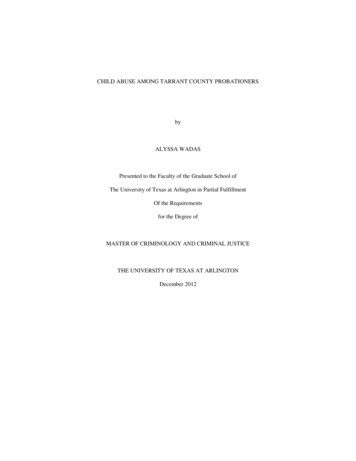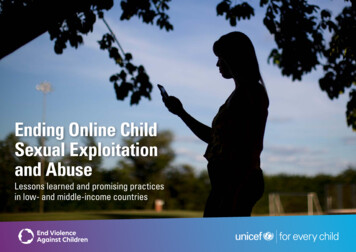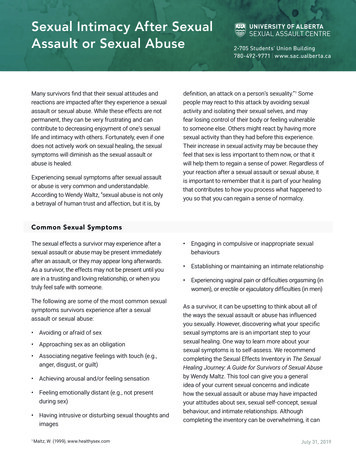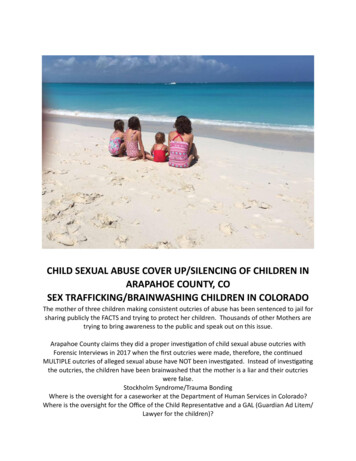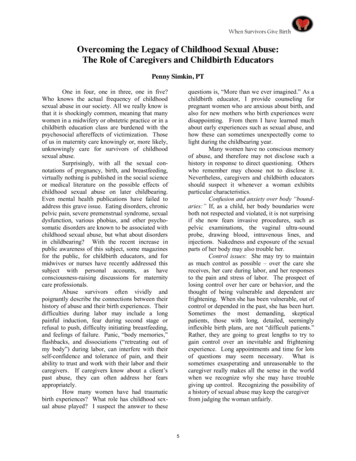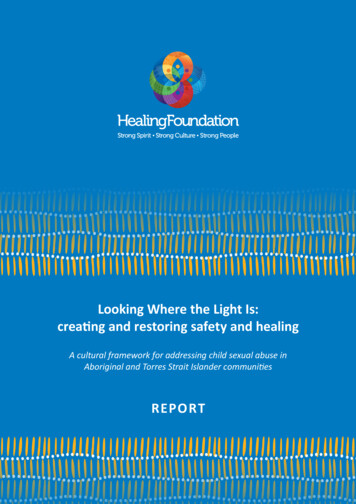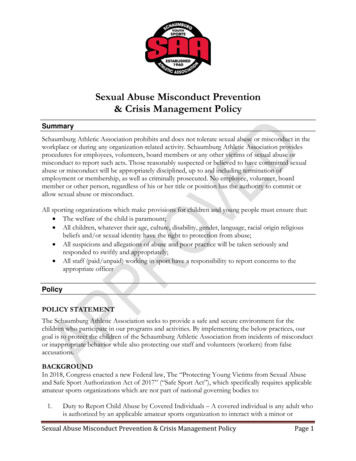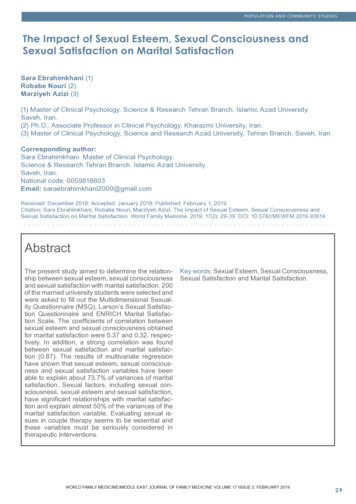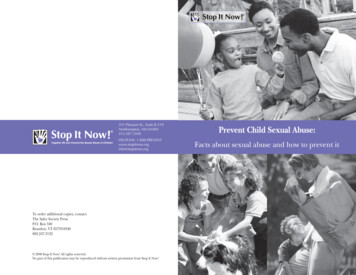
Transcription
351 Pleasant St, Suite B-319Northhampton, MA 01060413.587.3500351 Pleasant St., Suite B-319Northampton, MA 01060413.587.3500Prevent Child Sexual Abuse:HELPLINE: cts about sexual abuse and how to prevent itHELPLINE: 1.888.PREVENTwww.stopitnow.orginfo@stopitnow.orgTo order additional copies, contact:The Safer Society PressP.O. Box 340Brandon, VT 05733-0340802.247.3132 2008 Stop It Now! All rights reserved.No part of this publication may be reproduced without written permission from Stop It Now!
A Happiness Worth DefendingWhy Do We Need To LearnAbout Sexual Abuse of Children?Every day, adults miss real opportunitiesto prevent child sexual abuse becauseof misinformation and confusingstereotypes about sexual abuse. It isestimated that more than 300,000children are sexually abused every year.2Chances are, you already know a boy orgirl who has been sexually abused—andin all likelihood know someone who hasabused a child. By educating yourself,you can become a powerful force inmaking the world a safer place for kids.Kids are terrific—happy, innocent, and free. Theycan remind us of what is best about ourselves. Whenthey are sexually abused, that happiness is dimmed,sometimes for life. With your help, more kids will getto grow up full of light and life.One in three girls andone in seven boys aresexually abused beforeage 18.1Kids shouldn’t have to try to preventsexual abuse all by themselves. We adultshave to learn to recognize when peopleare acting inappropriately around ourchildren and to speak up before achild is harmed.Thank you for all you already do to help our childrengrow up free from sexual abuse.If you know of a child who is being sexually abused,call the Stop It Now! Helpline at 1.888.PREVENT forinformation on how to report it or visit us on the webat www.stopitnow.org.1It’s only in the last few decades that we,as a society, have started to acknowledgehow widespread child sexual abuse hasbeen and how much it hurts children.One in five adults report that theywere sexually abused as children, anexperience that increases vulnerabilityto depression, substance abuse,aggression, and other difficulties.4 Morethan 85% of adults who were abusedsay they never reported the abuse toauthorities.5In response to this new awareness,lawmakers have focused on managingconvicted sex offenders and publicizingtheir whereabouts. While thesemeasures have increased communityawareness, they address only a tinyportion of those who are at riskto sexually harm children—thosewho already have been caught andconvicted.Children are routinely taught tospeak up if someone approachesthem in a sexual way. But to make ourcommunities safe, we need to do more.Kids shouldn’t have the burden ofpreventing sexual abuse by themselves.Adults must act on their commitmentto keeping kids safe by learning torecognize and respond to inappropriatebehaviors around kids, before a childis harmed.And adultsIn 90% of child sexualhave toabuse cases, the childlearn whatknows and trusts theto do whenperson who sexuallyit seems likeabuses them.3someonemay besexually interested in children or isharming a child in a sexual way. Aswhen you see someone who is drinkingand planning to drive: you step forwardand offer help so they don’t hurtsomeone.This guidebook contains a lot of theinformation about how adults can stepforward and help protect children. Itdescribes what to look for and how totalk with other adults and with childrenabout preventing sexual abuse. It offersguidance about what to do when youhave a concern, even if you think,“Maybe I’m just over-reacting.” Andmost importantly, it offers informationabout who to call for advice, for help, orto report a case of abuse.2
What Exactly Is Child Sexual Abuse?If you’re not sure exactly what childsexual abuse is, you’re not alone.reported and those who haven’t—are fathers, mothers, step-parents,grandparents, and other familymembers (uncles, aunts, cousins). Orthey’re neighbors, babysitters, clergy,teachers, coaches, or anyone else whohas close contact with our children.When any adult engages in sexualactivity with a child, that is child sexualabuse. It is a crime in all 50 states.When the sexual activity is betweenchildren or adolescents, it is not alwaysso clear. Some kinds of sexual behaviorWe can’t tell who they are by the waybetween children might be innocentthey look. What they have in common isexplorations rather than abuse. Checkthat they think about sexual interactionsthe section called “Whatwith children andAbout Children Whothen they act on thoseIt’s hard to face theSexually Interact Withthoughts by sexuallyfact that someoneOther Children?” later inabusing a child. Wewe know—and eventhis guidebook for help inknow that child sexuallike—might befiguring out whether whatabuse happens everysexually inappropriateyou’re seeing betweenday across the country,with a child.children may be abuse,with little regard foror see Stop It Now!’ssocial classes, racial orguidebook, Do Children Sexually Abuseethnic groups, religious affiliations, orOther Children: Preventing sexual abusesexual orientation. That means thatamong children and youth.adults and youth who have sexuallyabused a child live in the sameneighborhoods, shop in the sameWho sexually abuses children?stores, and use the same parks that wePeople who sexually abuse childrendo. We may know them personally asare likely to be people we know, andpart of our family or extended family, orcould even be people we care about.in our circle of friends and neighbors.It would be easy to figure out whoBut we may not know about their sexualsexually abuses children if they wereinterests in kids.like the ones we see on TV—thosestrangers hanging around the edges ofIt’s hard to face the fact that someoneplaygrounds, or the “monsters,” whowe know and like might sexually abusekidnap and kill children. But truthfully, children. But because it’s true, we allthey’re hardly ever like that.need to know what to look for and howto make sure that everyone we knowMost often people who sexually abuselives up to an expectation of safety inchildren—both those who’ve beenour homes and communities.3Child Sexual Abuse IncludesTouching and Non-Touching BehaviorsTouching behaviors include:Non-touching behaviors include: Touching a child’s genitals (penis,testicles, vulva, breasts, or anus)for sexual pleasure or otherunnecessary purpose. Making a child touch someoneelse’s genitals, or playing sexual(“pants-down”) games. Putting objects or body parts (likefingers, tongue or a penis) insidethe vulva or vagina, in the mouth,or in the anus of a child for sexualpleasure or other unnecessarypurpose. Showing pornography to a child. Exposing a person’s genitals to achild. Asking children to interact sexuallywith one another. Online enticement of a child forsexual purposes. Photographing a child in sexualposes. Exposing a child to adult sexualactivity in person or through theuse of technology. Watching a child undress or usethe bathroom, often without thechild’s knowledge (known asvoyeurism or being a “PeepingTom”).If you see behaviors that concernyou, please call Stop It Now!’sconfidential toll-free Helpline at1.888.PREVENT for supportiveguidance, information or resources,or visit us on the web at www.stopitnow.org.4
Behavioral Symptomsof Possible Sexual AbuseSome of these behavioral signs can show up at other stressful times in a child’slife such as divorce, the death of a family member, friend or pet, or when thereare problems in school, as well as when abuse is involved. Any single sign doesn’tmean the child was abused, but several of them mean that you should begin toexplore the situation more fully.Do you notice some of the following behaviors in a child you know well? Nightmares, sleep problems,extreme fears without an obviousexplanation Sudden or unexplained personalitychanges; seems withdrawn, angry,moody, clingy, “checked-out” orshows significant changes in eatinghabits An older child behaving likea younger child (for example,bedwetting or thumb-sucking) Develops fear of certain places orresists being alone with an adult oryoung person for unknown reasons Shows resistance to routine bathing,toileting or removing clothes even inappropriate situations Play, writing, drawings or dreams ofsexual or frightening images Refuses to talk about a secret he orshe has with an adult or older child Stomach aches or illness, often withno identifiable reason Leaves clues that seem likely toprovoke a discussion about sexualissues Uses new or adult words for bodyparts Engages in adult-like sexual activitieswith toys, objects or other children Develops special relationship witholder friends that may includeunexplained money, gifts orprivileges Intentionally harms himself orherself, for example, drug/alcoholuse, cutting, burning, running away,sexual promiscuity Becomes increasingly secretivearound use of the Internet or cellphone Develops physical symptoms suchas unexplained soreness, pain orbruises around genital or mouth,sexually-transmitted disease, orpregnancyIf you see behaviors that concern you, please call Stop It Now!’s confidentialtoll-free Helpline at 1.888.PREVENT for supportive guidance, information orresources, or visit us on the web at www.stopitnow.org.5Why Do People Sexually Abuse?There is no “usual” pathway to a sexualoffense. Each person who sexuallyabuses a child is motivated by issuesthat are unique to that individual.Media images of “child molesters”and portrayals of their personalitiesmay actually make it more difficult torecognize inappropriate behaviors inthose we know.Sometimes, people who are attractedto adults and have intimate sexualrelationships with other adults maysexually approach children when theyare under unusual stress, like losing ajob or getting a divorce.Some people’s primary sexualattraction is children. (Some never acton those feelings.)Some people who sexually abusechildren were victims of abuse orneglect as children; it’s not an excuse,just a fact. Although having beenabused as a child heightens the risk forbecoming someone who sexually abuseschildren, the vast majority of sexualabuse victims live their lives without eversexually abusing others.Some people act impulsively, whenpresented with an unexpectedopportunity to sexually abuse a child.Others, particularly youth with highsocial status or with social or emotionaldelays, may not even fully understandthe harmful impact of their abusiveactions.“I turned myself in two and a half yearsago. I pled guilty because I wanted helpto stop molesting children.”Words of a man in prisonfor sexual abuseEasy access to child pornographyonline and sexually-oriented onlinechat groups have eliminated many ofthe hurdles that previously discouragedsome people from acting on theirsexual interests in minors. Viewingsexual images of children andparticipating in forums that supportsexual interactions involving childrenmay make sexually abusive behaviorseem “normal” or “acceptable” andthereby may increase the risk for handson offenses.Some adults sexually abuse a child tofeel the power and control they don’tfeel in their relationships with otheradults.These are just a few of the many reasonswhy someone may choose to sexuallyabuse a child. No reasons excuse orjustify sexualized behaviors involving achild. No matter what the reason for theabuse, the effects on children may besevere and may last a lifetime.6
“Twenty-five years ago Iwas a respected memberof my community,publisher of our localpaper, and a sexualabuser. Being arrestedwas the best thing thatcould have happenedto me at the time. I waslucky to get treatment and it worked. I havenow been back in societyfor nearly 17 years andhave not abused again. Ihave been given a secondchance and I will notthrow that away.”Words of a personwho completedtreatmentCan People Who SexuallyAbuse Children Stop It?What About Children Who SexuallyInteract With Other Children?Yes! In order to stop, people who sexually abusechildren must want to change and must be able toget specialized treatment. Adults, adolescents, andchildren with sexual behavior problems can changetheir abusing behavior. They can learn to live healthy,productive lives in which they no longer harminnocent children.When children or adolescents interactin a sexual way, it is sometimes difficultto tell the difference between naturalsexual curiosity and potentially abusivebehaviors.Some sexualMore than a thirdactivities areof all sexual abusenormal foris committed bychildren atsomeone under thecertain ages.age of 18.6Children,particularlyyoungerchildren, may engage in inappropriateinteractions without understanding thehurtful impact it has on others. For thisreason, it may be more helpful to thinkin terms of a child’s sexually “harmful”behavior rather than sexually “abusive”behavior.You’ve probably heard or read the misinformationthat all people who have sexually abused will abuseagain. With all those stories on TV and in the papers,it’s not easy to remember that the people who abusehundreds of victims are only a few, really extremecases. Most people who sexually abuse children arenot like those you see on TV.Treatment works. Many people who abuse will learn tocontrol themselves around children if they are offeredspecialized treatment and appropriate communityoversight. When people with sexual behavior problemshave support and are accountable to their friendsand families, they are more likely to complete theirtreatment programs and live productive, abuse-freelives. Again, when we confront these behaviors at theearliest stages, especially in children and teens, theyare most likely to change and not abuse again.If you are concerned about your own or someoneelse’s sexualized behaviors towards children, pleasecall Stop It Now!’s confidential toll-free nationalHelpline at 1.888.PREVENT (1.888.773.8368) forsupportive guidance, information or resources, or visitus on the web at www.stopitnow.org.But there are some features ofinteractions that should raise concernsif you see children involved in sexualplay. Consider:Size: Is one of the children/teensinvolved much larger or stronger thanthe other?Status: Does one of the children/teenshave more power in the relationship —for example, a babysitter, a club or teamleader, a socially popular child whobullies others?Ability: Does one of the children/teens have greater mental, emotional,or physical ability than the other?Is the possible victim disabled ordevelopmentally delayed?Power: Is one of the children/teensusing tricks, threats, bribes, or physicalforce?If you answered “yes” to any of thesequestions, the sexual activity may beabusive and a report to child protectiveservices may be appropriate. If youhave any questions about what youare seeing, or if you need support,please call Stop It Now!’s confidentialtoll-free, national Helpline 1.888.PREVENT (1.888.773.8368). You canspeak confidentially with a professionalabout your concerns, and learn whatoptions and local resources are availableto you. Remember, you do not need tobe sure that it is abuse to call. By calling,you learn how to get help for all of thechildren involved.“I made the most difficult decision of my life—I decided toreport my son for sexually abusing another child.But our lives are better in many ways. He is getting the helphe needs to stop.”Mother of teen with sexual behavior problems78
What Is Age-AppropriateSexual Behavior?While learning about their bodies and sexuality, childrenmay behave in ways that seem out of sync with their age ordevelopmental stage. The chart below describes kinds of behaviorthat are common and less common in a given developmentalstage. Many factors—for example, having an older sibling orunsupervised exposure to certain television, films, games or songlyrics—may increase a child’s awareness of knowledge, attitudesand behaviors of an older age group. Usually, unexpectedbehavior can be redirected with a simple instruction. Ofparticular concern are uncommon behaviors that a childseems unable to control after being asked to stop.Preschool (0 to 5 years of age)Common: Sexual language relating to differences inbody parts, bathroom talk, pregnancy and birth. Genitalstimulation at home and in public. Showing and lookingat private body parts.Uncommon: Discussion of specific sexual acts or explicit sexuallanguage. Adult-like sexual contact with other children.School-age children (6 to 12 years of age)May include both pre-pubescent children and children whohave already entered puberty, when hormonal changesare likely to trigger an increase in sexual awarenessand interest.Before pubertyCommon: Questions about relationships and sexual behavior,menstruation and pregnancy. Experimentation with same-agechildren, often during games, kissing, touching, exhibitionismand role-playing. Private genital stimulation.Uncommon: Adult-like sexual interactions, discussing specificsexual acts or public genital stimulation.9After puberty beginsCommon: Increased curiosity about sexual materials andinformation, questions about relationships and sexual behavior,using sexual words and discussing sexual acts, particularly withpeers. Increased experimenting including open-mouthed kissing,body-rubbing, fondling. Masturbating in private.Uncommon: Consistent adult-like sexual behavior, including oral/genital contact or intercourse. Masturbating in public.Adolescence (13 to 16 years of age)Common: Questions about decisionmaking, social relationships, andsexual customs. Masturbation in private.Experimenting between adolescents of thesame age, including open-mouthed kissing, fondlingand body rubbing, oral/genital contact. Also, voyeuristicbehaviors are common. Intercourse occurs inapproximately one-third of this age group.Uncommon: Masturbating in public andsexual interest directed toward muchyounger children (for example, non-peers).If you see behaviors thatconcern you, please call StopIt Now!’s confidential toll-freenational Helpline at 1.888.PREVENT(1.888.773.8368) for supportive guidance,information or resources, or visit us on theweb at www.stopitnow.org.Adapted from Wurtele, S.K. and Miller-Perrin, C.L.Preventing Sexual Abuse. University of Nebraska Press.Lincoln, NE. 1992.10
What To Watch ForWhen Adults Are With ChildrenWhat YOU Can DoEveryone needs to speak up.When we don’t take the keys from adrunk friend who’s about to drive,we’re risking that friend’s and otherpeople’s lives on the road. When wedon’t question a friend’s sexualizedcomments or behaviors toward a child,we’re risking the well-being of ourchildren and the future of the friend.People who sexually abuse children relyon our confusion and on our reluctanceto acknowledge discomfort. Adults –all of us—need to talk together aboutsexual abuse and to learn what to do tokeep children safe. The first steps aresetting clear boundaries and limits witheveryone involved in our family andsocial circle and speaking up when anyof those rules are broken.Often, families whose kids were sexuallyabused wish that they had talked moreopenly beforehand with their childrenin ways that would have made themless vulnerable when someone triedto approach them sexually. By gettingcomfortable using words like “penis”,“vagina”, or “penetration,” we adultscan teach our sons and daughters howto talk about it when they are madeuncomfortable. When adults and kidshave the right words, it’s easier forkids to tell us when they are sexuallyapproached or harmed. Shyness orembarrassment about sexual behaviorscan also make it more difficult to talkwith someone who may be actinginappropriately toward a child.“My brother-in-law Harry was touching hiseleven-year-old daughter. She was clearlyuncomfortable with his attention. ‘Don’tworry about it,’ I told her. ‘Your daddoesn’t mean anything by it.’I wish I had told Harry, in front of my niece, ‘I see Janice isuncomfortable. You should stop touching her like that.’ Thiswould let my niece know that it is okay to say ‘no’ to him. It wouldlet Harry know that someone is watching and noticing and notafraid to speak up.”Aunt of a child who was abused11Have you ever seen someone playing with a child and feltuncomfortable with it? Maybe you thought, “I’m just over-reacting,”or, “He/She doesn’t really mean that.” If you are uncomfortable,but don’t see specific signs, trust your instincts and ask morequestions. Below is a list of behaviors that might be cause forconcern.Do you know an adult, adolescent or older child who: Makes others uncomfortable by ignoring social, emotional orphysical boundaries or limits? Refuses to let a child set any of his or her own limits? Usesteasing or belittling language to keep a child from setting a limit? Insists on hugging, touching, kissing, tickling, wrestling with orholding a child even when the child does not want this physicalcontact or attention? Frequently makes sexual references or tells sexual or suggestivejokes with children present? Exposes a child to adult sexual interactions without apparentconcern? Has secret interactions with teens or children (such as games,sharing drugs, alcohol, or sexual material) or spends excessivetime emailing, text messaging or calling children or youth? Seems “too good to be true,” for example, baby sits differentchildren for free; takes children on special outings alone; buyschildren gifts or gives them money for no apparent reason? Allows children or teens to consistently get away withinappropriate behaviors?If you answered “yes” to some of these questions, talk to thatperson. For more information and supportive guidance aboutstarting a conversation with someone, see our Let’s Talk guidebookon our website at www.stopitnow.org or please call Stop It Now!’sconfidential toll-free national Helpline at 1.888.PREVENT(1.888.773.8368).12
Develop A Safety Action PlanFor Your FamilyIt is important to teach childrenabout safety. It is more importantto teach ourselves what weneed to know in order to keepour children and communitiessafe. Here are some things thatyou and your family can do toprevent the sexual abuse ofchildren. Adults need to:Take responsibility Adults must watch for anyinappropriate behaviors inother adults or older youthbecause children, especiallyyoung ones, are not as able torecognize these behaviors orto protect themselves. Stay attuned to your children’suse of technology – Internet,email, instant messaging,webcam use, peer-to-peer13and social networking sites,and cell use, including photoexchanges. Model safe choicesand behavior. The illusion ofanonymity on these electronicmediums often leads to abreakdown of social rules andexpectations that would beassumed if the interactionswere face-to-face. Wheneverpossible, keep the interactionsvisible and public. Kids, andeven adults can easily stumbleinto inappropriate or possiblydangerous situations andexchanges. Educate yourself.Establish clear, firm guidelinesand stick to them. Show in your own life howto say “no.” Teach yourchildren that their “no” willbe respected, whether it’s inplaying or tickling or huggingand kissing. For instance, ifyour child does not want togive Grandma a kiss, let thechild shake hands instead.And, make sure Grandmaunderstands why this isimportant for the safety of thechild.Learn, teach, and practice Set and respect familyboundaries. All membersof the family have rights toprivacy in dressing, bathing,sleeping, and other personalactivities. If anyone does notrespect these rights, an adultshould clearly tell them thefamily rules. Speak up when you see anyinappropriate behaviors.Interrupt and talk withwhoever is making youuncomfortable in a situationor with someone in a positionto intervene. They may needhelp to stop these behaviors. Report anything you know orsuspect might be sexual abuse.If nobody speaks up, the abusewill not stop. Practice talking with otheradults about difficult topics.Say the words out loud so thatyou become more comfortableusing the words, askingquestions, and confrontingbehaviors. Be receptive with both theadults and the children in yourlife about their difficult issues.Help them get comfortabletalking with you. Show themthat you will listen to anythingthey have to say, even ifthey talk about somethingembarrassing or somethingthey’ve done wrong. Use the proper names of bodyparts. Just as you teach yourchildren that a nose is a nose,they need to know what to calltheir genitals. This knowledgegives children correctlanguage for understandingtheir bodies, for askingquestions that need to beasked, and for telling aboutany behavior that could leadto sexual abuse. Be clear with adults andchildren about the differencebetween okay touch and touchthat is not okay. For youngerchildren, teach more concreterules such as “talk with meif anyone—family, friend, or14
Develop A Safety Action PlanFor Your Family (cont.)anyone else—touches yourprivate parts.” Also teachkids that it is not okay to usemanipulation or control totouch someone else’s body. Explain to the adults andchildren you know about thedifference between a secretand a surprise and show themhow secrets may make kidsunsafe. Surprises are joyfuland generate excitement inanticipation of being revealedafter a short period of time.Secrets exclude others, oftenbecause the information willcreate upset or anger. Whenkeeping secrets with just oneperson becomes routine,children are more vulnerableto being abused. Make it clear that childrenwill be supported whenthey request privacy or say“no” to an activity or a kindof touch that makes themuncomfortable. Give kids permission to tellanyone they trust if theyfeel scared, uncomfortableor confused by someone’sbehavior toward them.Make a plan Create a family safety planthat is clear to everyone andeasy to follow (www.stopitnow.downloads/SafetyPlan.pdf).Make sure that as adults,you know how to challengeeach other when you see anyinappropriate behaviors. Listwho to talk with when you seesomething you are unsureabout and who to call if youbelieve there is a need toreport sexual abuse. Teachchildren about what to doand who to talk with if theyare sexually threatened ortouched by someone. Make a list of people andorganizations you can callfor advice, information, andhelp. (Check the resourcesat the end of this booklet.)Even if you do not havechildren of your own, you canbe a resource about how toreport and how to get help foreveryone involved. If you knowthat a child has been sexuallyabused, be sure to get help forthe child quickly, so the harmcan be healed.Physical Warning Signsthat A Child May Have Been AbusedDoes a child close to you have: Unexplained bruises, redness, or bleeding of the child’sgenitals, anus, or mouth? Pain at the genitals, anus, or mouth? Genital sores or milky fluids or repeated infections in thegenital area?If you said “yes” to any of these examples, bring your child to adoctor or emergency room. A doctor can help you understandwhat may be happening and test for sexually transmitted diseases.If you have any questions about these or other signs and symptomsor see behaviors that concern you, please call Stop It Now!’sconfidential toll-free national Helpline at 1.888.PREVENT(1.888.773.8368) for supportive guidance, information orresources, or visit us on the web at www.stopitnow.org.1516
Signs That an Adult May BeAt-Risk to Sexually Abuse a ChildSomeone you care about may be acting in ways that worry you. These behaviorsmay indicate a risk to sexually abuse a child or may be a way for this person to askfor help. Many people with sexual behavior problems wish someone had askedthem what was going on or had told them where to call. Inappropriate behaviorsmay become abusive if the individual does not get the help he or she needs.Do you know someone who: Misses or ignores social cues aboutothers’ personal or sexual limits orboundaries? Spends most of spare time withchildren and shows little interest inspending time with another adult? Links sexuality and aggression inlanguage or behavior, for example,sexualized threats or insults, like“whore” or “slut”? Makes fun of children’s body parts,describes children with sexual wordslike “stud” or “sexy” or talks againand again about the sexual activitiesof children or teens? Has an interest in sexual fantasieswith children or is unclear aboutwhat’s appropriate with children? Minimizes hurtful or harmfulbehaviors when confronted; blamesothers or denies harmfulness of actions or words despite impact?Often has a “special” child friend,maybe a different one each year?Encourages silence and secrets inchildren?Masturbates so often that it getsin the way of important day-to-dayactivities?Was physically, sexually oremotionally mistreated or abusedas a child and has not adequatelyaddressed the possible effects?Downloads/views Internetpornography and is not willing toshow if children are involved?Becomes so pre-occupied with theInternet sexual activity that it startsto impact family and/or work life.Asks adult partners to dress or actlike a child or teen during sexualactivity?While single behaviors, in themselves, do not indicate that an individual islikely to engage in sexually-harmful behaviors, these behaviors, especially incombination, may strongly suggest that an adult or adolescent needs help. Ifyou see behaviors that concern you, please call Stop It Now!’s confidential tollfree Helpline at 1.888.PREVENT (1.888.773.8368) for supportive guidance,information or resources, or visit us on the web at www.stopitnow.org.17Community Notification and YouWhat is community notification?All states have enacted sex offenderregistration laws as a means of providinglaw enforcement with an additionalinvestigative tool. Communitynotification laws authorize the publicrelease of information about certainregistered sex offenders. You maybe notified by a law enforcementofficer when a convicted sex offenderhas moved into your neighborhood.In many communities, notificationincl
Prevent Child Sexual Abuse: Facts about sexual abuse and how to prevent it 351 Pleasant St, Suite B-319 Northhampton, MA 01060 413.587.3500 HELPLINE: 1.888.PREVENT

